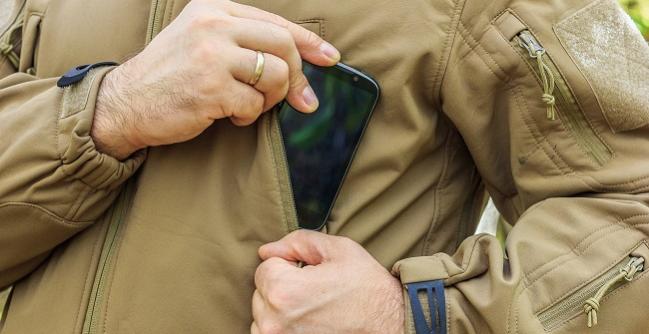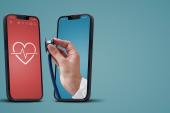Smartphone in Your Pocket Predicts 5-Year Risk of Dying
The phone’s sensors captured the intensity of movement and may be best suited to conditions like congestive HF or COPD.

That smartphone in your pocket can predict your 5-year risk of dying, all without requiring special apps, activity trackers, or watches, according to a study published this week.
Passively collecting just 6 minutes of walking data from the built-in motion sensors of smartphones accurately predicted the risk of all-cause mortality among participants in the UK Biobank study, reported Bruce Schatz, PhD (University of Illinois at Urbana-Champaign), and colleagues online October 20, 2022, in PLoS Digital Health.
“We wanted to see if we could find the equivalent of the more-controlled hospital walking tests and only use the inputs to the models that a phone could provide,” Schatz told TCTMD, noting that the smartphone’s motion sensors are capturing the intensity of walking. “It’s about the quality of physical activity,” he added. “It’s very different than what smart watches are usually used for. With smart watches, they’re capturing how many minutes a day you’re active. It’s counting steps, which is more about quantity.”
I believe the most likely thing this will do is pick up heart problems in patients who have gone down in their function in the recent past or people who didn’t even know there was a problem. Bruce Schatz
It’s well known there is a strong correlation between physical activity levels and all-cause mortality. Roughly a decade ago, Schatz said a discussion with physicians led them to speculate if there might be some way to passively track people in their daily lives—as opposed to them wearing smartwatches or fitness trackers—and whether it could be used to predict current and future health status.
“At the time, we had hoped things like ‘smart clothes,’ with sensors up and down the body, would happen, but the device that emerged was phones,” he said. “We asked, could we do anything useful medically with just carrying the phone around? I must confess that many people, including myself, thought no. It turns out that many common diseases, particularly heart and lung diseases, things like congestive heart failure and COPD [chronic obstructive pulmonary disease], have characteristic motions that can be used to predict status.”
Expert healthcare professionals, said Schatz, can generally identify the current health status of patients based on their gait and walking ability. “There’s very characteristic motions of people—they’ll slow or stop to catch their breath, for example—and we knew that this was something you could capture, even with cheap devices,” he explained.
Continuous, Short-term Monitoring
In previous studies, the researchers showed that data derived from the phone’s motion sensors, which were carried while cardiopulmonary patients performed a standard 6-minute walk test, accurately predicted pulmonary function measured by spirometry. Similarly, data from the phone’s motion sensors could accurately predict oxygen saturation levels in cardiopulmonary patients. That study also showed that the motion sensors could predict the transition of patients between health status levels.
With this in mind, Schatz and colleagues wanted to determine if the motion sensors in phones could predict all-cause mortality. To do so, they turned to data from the UK Biobank study, a large-scale database with genetic and health information for roughly 500,000 people. As part of that study, 100,655 participants wore activity monitors with motion sensors on their wrists for 1 week. From these activity monitors, the researchers extracted sensor inputs that would also be available on inexpensive, currently available phones. The raw sensor data of walking intensity was captured in twelve 30-second bursts, and these 6 minutes represented a daily living version of the standard walk test, say investigators.
With a machine-learning model, they analyzed the motion sensor data and mortality in roughly 10% of patients and developed an algorithm from the sensor inputs to estimate the 5-year risk of all-cause mortality using acceleration captured over 6 minutes. Over the entire cohort, the predictive model had a C-index of 0.76 and 0.73 at 1 and 5 years, respectively.
According to the investigators, the predictive accuracy of the algorithm is on par with other active measures of gait speed and walking pace, which use physical walk tests and self-reported questionnaires.
In terms of the clinical implications, Schatz imagines smartphone monitoring of physical activity can help physicians better assess and track patients. For example, the data could be used to provide continuous prediction of all-cause mortality at 6-month intervals in patients over a certain age or in those who had worrisome test results. The other area where smartphones might be helpful would be in assessing status changes in at-risk patients, such as congestive heart failure patients or those with COPD.
“The phones are already connected to a network, so you can get the data to the backend that does the analysis and puts it in the electronic medical record,” said Schatz. “When I used to speak with hospital people, I would say this is the home version of the medical alert. Most hospitals have programs that run all the time and look for unusual events that they should flag and pass on to the physicians. The point of this was to turn a cheap phone into a medical device.”
Schatz emphasized that even though none of the current research directly involves cardiovascular disease, he believes this is the area where it will be most useful.
“CVD is hard to detect in everyday life without hospital visits,” he said. “Screening isn’t perfect, but it can pick up cases you’d normally not see. That’s the real value. I believe the most likely thing this will do is pick up heart problems in patients who have gone down in their function in the recent past or people who didn’t even know there was a problem.”
Michael O’Riordan is the Managing Editor for TCTMD. He completed his undergraduate degrees at Queen’s University in Kingston, ON, and…
Read Full BioSources
Zhou H, Zhu R, Ung A, Schatz B. Population analysis of mortality risk: predictive models from passive monitors using motion sensors for 100,000 UK Biobank participants. PLOS Digit Health. 1(10): e0000045.





Comments